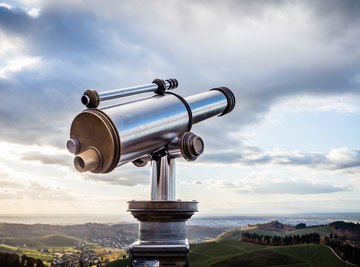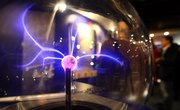
Snap your fingers! In the time it took to do that, a light beam was able to travel almost all the way to the moon. If you snap your fingers once more, you'll give the beam time to complete the journey. The point is that light travels really, really fast.
Light travels quickly, but its speed isn't infinite, as people believed before the 17th century. The speed is too fast to measure using lamps, explosions or other means that depend on human visual acuity and human reaction time, however. Ask Galileo.
Light Experiments
Galileo devised an experiment in 1638 that used lanterns, and the best conclusion he could manage was that light is "extraordinarily rapid" (in other words, really, really fast). He wasn't able to come up with a number, if he did, in fact, even try the experiment. He did, however, venture to say that he believed light travels at least 10 times as fast as sound. Actually, it's more like a million times as fast.
The first successful measurement of the speed of light, which physicists universally represent by a lowercase c, was made by Ole Roemer in 1676. He based his measurements on observations of Jupiter's moons. Since then, physicists have used observations of the stars, toothed wheels, rotating mirrors, radio interferometers, cavity resonators and lasers to refine the measurement. They now know c so accurately that the General Council on Weights and Measures based the meter, which is the fundamental unit of length in the SI system, on it.
The speed of light is a universal constant, so there is no speed of light formula, per se. In fact, if c were any different, all our measurements would have to change, because the meter is based on it. Light does have wave characteristics, though, which include frequency ν and wavelength λ, and you can relate these to the speed of light with this equation, which you might call the equation for the speed of light:
Measuring the Speed of Light from Astronomical Observations
Roemer was the first person to come up with a number for the speed of light. He did it while observing the eclipses of of Jupiter's moons, specifically Io. He would watch Io disappear behind the giant planet and then time how long it took to reappear. He reasoned that this time could differ by as much as 1,000 seconds, depending on how close Jupiter was to the earth. He came up with a value for the speed of light of 214,000 km/s, which is in the same ballpark as the modern value of almost 300,000 km/s.
In 1728, English astronomer James Bradley calculated the speed of light by observing stellar aberrations, which is their apparent change in position due to the earth's motion around the sun. By measuring the angle of this change and subtracting the speed of the earth, which he could calculate from data known at the time, Bradley came up with a much more accurate number. He calculated the speed of light in a vacuum to be 301,000 km/s.
Comparing the Speed of Light in Air to the Speed in Water
The next person to measure the speed of light was French philosopher Armand Hippolyte Fizeau, and he didn't rely on astronomical observations. Instead, he constructed an apparatus consisting of a beam splitter, a rotating toothed wheel and a mirror placed 8 km from the light source. He could adjust the speed of rotation of the wheel to allow a beam of light to pass toward the mirror but block the return beam. His calculation of c, which he published in 1849, was 315,000 km/s, which wasn't as accurate as Bradley's.
A year later, Léon Foucault, a French physicist, improved on Fizeau's experiment by substituting a rotating mirror for the toothed wheel. Foucault's value for c was 298,000 km/s, which was more accurate, and in the process, Foucault made an important discovery. By inserting a tube of water between the rotating mirror and the stationary one, he determined that the speed of light in air is higher than the speed in water. This was contrary to what the corpuscular theory of light predicted and helped establish that light is a wave.
In 1881, A. A. Michelson improved upon Foucault's measurements by constructing an interferometer, which was able to compare the phases of the original beam and the returning one and display an interference pattern on a screen. His result was 299,853 km/s.
Michelson had developed the interferometer to detect the presence of the ether, a ghostly substance through which light waves were thought to propagate. His experiment, conducted with physicist Edward Morley, was a failure, and it led Einstein to conclude that the speed of light is a universal constant that is the same in all reference frames. That was the foundation for Special Relativity Theory.
Using the Equation for the Speed of Light
Michelson's value was the accepted one until he improved on it himself in 1926. Since then, the value has been refined by a number of researchers using a variety of techniques. One such technique is the cavity resonator method, which uses a device that generates electric current. This is a valid method because, following the publication of Maxwell's equations in the mid-1800s, physicists have been in agreement that light and electricity are both electromagnetic wave phenomena, and both travel at the same speed.
In fact, after Maxwell published his equations, it became possible to measure c indirectly by comparing the magnetic permeability and electric permeability of free space. Two researchers, Rosa and Dorsey, did this in 1907 and calculated the speed of light to be 299,788 km/s.
In 1950, British physicists Louis Essen and A.C. Gordon-Smith used a cavity resonator to calculate the speed of light by measuring its wavelength and frequency. The speed of light is equal to the distance light travels d divided by the time it takes ∆t: c = d/∆t. Consider that the time for a single wavelength λ to pass a point is the period of the waveform, which is the reciprocal of the frequency v, and you get the speed of light formula:
The device Essen and Gordon-Smith used is known as a cavity resonance wavemeter. It generates an electric current of a known frequency, and they were able to calculate the wavelength by measuring the dimensions of the wavemeter. Their calculations yielded 299,792 km/s, which was the most accurate determination to date.
A Modern Measurement Method Using Lasers
One contemporary measurement technique resurrects the beam-splitting method employed by Fizeau and Foucault, but uses lasers to improve accuracy. In this method, a pulsed laser beam is split. One beam goes to a detector while another travels perpendicularly to a mirror placed a short distance away. The mirror reflects the beam back to a second mirror which deflects it to a second detector. Both detectors are hooked up to an oscilloscope, which records the frequency of the pulses.
The peaks of the oscilloscope pulses are separated because the second beam travels a greater distance than the first one. By measuring the separation of the peaks and the distance between the mirrors, it's possible to derive the speed of the light beam. This is a simple technique, and it yields fairly accurate results. A researcher at the University of New South Wales in Australia recorded a value of 300,000 km/s.
Measuring the Speed of Light No Longer Makes Sense
The measuring stick used by the scientific community is the meter. It was originally defined to be one ten-millionth of the distance from the equator to the North Pole, and the definition was later changed to be a certain number of wavelengths of one of the emission lines of krypton-86. In 1983, the General Council on Weights and Measures scrapped those definitions and adopted this one:
The meter is the distance traveled by a beam of light in a vacuum in 1/299,792,458 of a second, where the second is based on the radioactive decay of the cesium-133 atom.
Defining the meter in terms of the speed of light basically fixes the speed of light at 299,792,458 m/s. If an experiment yields a different result, it just means the apparatus is faulty. Rather than conducting more experiments to measure the speed of light, scientists use the speed of light to calibrate their equipment.
Using the Speed of Light to Calibrate Experimental Apparatus
The speed of light shows up in a variety of contexts in physics, and it's technically possible to calculate it from other measured data. For example, Planck demonstrated that the energy of a quantum, such as a photon, is equal to its frequency times the Planck constant (h), which is equal to 6.6262 x 10-34 Joule⋅second. Since frequency is c/λ, Planck's equation can be written in terms of wavelength:
By bombarding a photoelectric plate with light of a known wavelength and measuring the energy of the ejected electrons, it's possible to get a value for c. This type of speed of light calculator isn't necessary to measure c, however, because c is defined to be what it is. However, it could be used to test the apparatus. If Eλ/h does not come out to be c, something is wrong either with the measurements of the electron energy or the wavelength of the incident light.
The Speed of Light in a Vacuum Is a Universal Constant
It makes sense to define the meter in terms of the speed of light in a vacuum, since it's the most fundamental constant in the universe. Einstein showed that it is the same for every reference point, regardless of motion, and it's also the fastest anything can travel in the universe – at least, anything with mass. Einstein's equation, and one of the most famous equation in physics, E = mc2, provides the clue as to why this is so.
In its most recognizable form, Einstein's equation applies only to bodies at rest. The general equation, however, includes the Lorentz factor γ, where
For a body in motion with a mass m and velocity v, Einstein's equation should be written E = mc2γ. When you look at this, you can see that when v = 0, γ = 1 and you get E=mc2.
However, when v = c, γ becomes infinite, and the conclusion you have to draw is that it would take an infinite amount of energy to accelerate any finite mass to that speed. Another way of looking at it is that mass becomes infinite at the speed of light.
The current definition of the meter makes the speed of light the standard for terrestrial measurements of distance, but it has long been used to measure distances in space. A light year is the distance that light travels in one earthly year, which turns out to 9.46 × 1015 m.
That many meters is too many to comprehend, but a light year is easy to understand, and because the speed of light is constant in all inertial reference frames, it's a reliable unit of distance. It's made slightly less reliable by being based on the year, which is a time frame that would have no relevance to anyone from a different planet.
References
- Speed of Light: Historical Measurements
- UC Riverside: How Is the Speed of Light Measured?
- Optical Engineering Fundamentals, Second Edition: Speed of Light
- The Star Garden: How We Came to Know the Cosmos: Light & Matter
- University of New South Wales: Speed of Light
- The Physics of the Universe: E = MC^2
About the Author
Chris Deziel holds a Bachelor's degree in physics and a Master's degree in Humanities, He has taught science, math and English at the university level, both in his native Canada and in Japan. He began writing online in 2010, offering information in scientific, cultural and practical topics. His writing covers science, math and home improvement and design, as well as religion and the oriental healing arts.
